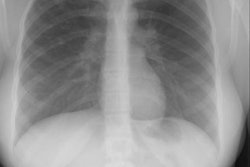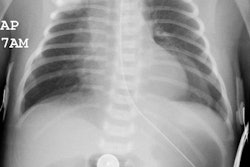Birt-Hogg-Dub? syndrome:
- Clinical:
Birt-Hogg-Dub? syndrome (BHD) is a autosomal dominant multiorgan
systemic disorder that consists of cutaneous lesions, renal
tumors,
lung cysts, and spontaneous pneumothorax [1]. It is caused by a
mutation in the folliculin gene on chromosome 17 [2]. The classic
skin
findings are the triad of hamatomas of the hair follicles
(fibrofolliculomas), tumors of the hair disk (trichodiscomas), and
skin
tags (acrochordons) [1]. Fibrofolliculomas are the most
characteristic
finding of BHD syndrome and typically appear as multiple, 2-4 mm,
whitish, smooth, dome-shaped papules on the head, neck, face and
upper
trunk in patients in the 3rd to 4th decade of life [1].
Patients also develop renal tumorsnalmost 7 fold increased risk [2]) that are often multiple and bilateral including hybrid chromophobe oncocytomas (50%), chromophobe carcinomas (34%), clear cell carcinomas (9%), oncocytomas (5%), and papillary renal cell cancer (2%) [1].
Finally, lung cysts can be found in 77-89% of patients- typically variable in size (from a few millimeters to 2 cm) and shape (ellipsoid or biconvex), commonly para-mediastinal in location (88-94% of patients with BHD syndrome have para-mediastinal cysts, as opposed to 36-43% of LIP patients, and 6-12% of patients with LAM [3]), with a lower lobe predominance (87% of patients) [1,3]. The cysts are typically subpleural, interlobular septa, septopleural junction, and perivascular regions adjacent to the central pulmonary arteries and, when large, are often multi-septated [1]. The incidence of spontaneous pneumothorax has been estimated to be approximately 33-43% [1,2].
REFERENCES:
(1) AJR 2011; Thoracic CT findings in Birt-Hogg-Dub? syndrome. 196: 349-352
(2) Radiographics 2011; Kanne JP, et al. Beyond skin deep:
thoracic
manifestations of systemic disorders affecting the skin. 31:
1651-1668
(3) AJR 2019; Escalon JG ,et al. Isolated cystic lung disease: an
algorithmic approach to distinguishing Birt-Hogg-Dube syndrome,
lymphangioleiomyomatosis, and lymphocytic interstitial pneumonia.
212: 1260-1264




